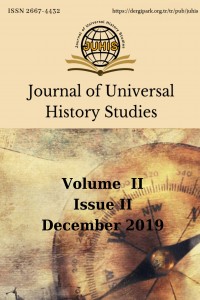Abstract
Selçuklular yaklaşık 150 yıl(M.S. 1041-1187)Kirman’da hüküm sürdü ve arkalarında tarihi yapılar bıraktılar. Temel deneysel bir araştırma olarak bu çalışma,tarihi yapılardan biri olan Kral Atabak’ın mezarının şuan ki halini ve restore edildikten sonraki dış cephesinin durumunu incelerken,bu tarihi yapıyı tanıtmayı amaçlar. Verilerin toplanabilmesi için saha çalışmaları ile birlikte kütüphane sonuçları da kullanılmıştır.Araştırma şu soruları içerir: 1)Kral Atabak’ın mezarı kime ait ve tam olarak ne zaman inşa edildi ? 2) Bu yapıttaki dekoratif detaylar nelerdir ? 3) Bu yapıtın şuan ki durumu nedir ? Çalışmanın sonuçları, Kral Atabak’ın mezarının 12. yüzyılda, İran’ın en güzel anıtlarından biri olduğunu ve özellikle çeşitli süslemelerle ve kitabelerin yazılarıyla ünlü olduğunu gösteriyor. Bu anıtta, tuğla süslemeleri, Negin çinileri, farklı sıva çalışmaları, geometrik ve doğal şekiller, düğümlü Kufi yazıtları, thulut hat sanatı ve daha pek çok zarif dekorasyon görülebilir. Bütün bu güzelliğe rağmen, bu yapıt pek bilinmemektedir ve yazarın on yıl boyunca meşgul olmasını sağlayan önemli bir restorasyon gerektirir.
References
- [1] Bosworth, Clifford Edmund et al. (2001). The Seljuq Dynasty, Azhand Y., Offside: Moses.
- [2] Bondari Isfahani (1976). The history of the Seljuq dynasty, Zobdat al-Nusra va Nokhbat al-Osra. Jalili M.H., Offset: The Iranian Culture Foundation Press.
- [3] Boyle, J.A. (2001). History of Iran Cambridge (From the coming of the Seljuq to the collapse of the Ilkhanid Dynasty, Anousheh, H., Tehran: Amir Kabir Press.
- [4] Hosseini, S. (2003). Akhbar al-Dolata al-Siljuq. Nazari, J., Tehran: Islamic Azad University, Firoozabad.
- [5] Ibn Athir, E. (1984). Full History of Islam and Iran. Offside: Iranian Books Press.
- [6] Javadi, S. (2003). The Emergence of Color in Outer Decoration of Monuments, the Case of Khaje Atabak’s Tomb, with the Oldest Negin Tiles in Iran, Modares-e Honar, 1,3.
- [7] Kermani, A. (2004). Collection of Afzal al-Din Abuhamed Kermani’s Works. Shahid Bahonar University Publication, Kerman.
- [8] ________ (1976). Aghd al-ola lelmoghofe al-A’ala, translated by Amiri Naini, A., Tehran: Rouzbehan Press.
- [9] ________ (1947). Badaye al-Zaman fi Vaghaye Kerman. Developed by Bayani, M., Tehran: University of Tehran.
- [10] Kiani, M. (2009). The History of Art and Architecture in the Islamic Era. Samt Publication, Tehran.
- [11] Khabisi, M. (1994). Seljuks and Qoz in Kerman, with a preface from Bastani Parizi. Safa.
- [12] Khandmir, Gh. (1974). Habib Al-Seri fi Akhbar Al-Bashar. Offset: Khayyam Bookstore, Vol. II, Second Edition.
- [13] Kuhnl, E. (1968). Islamic Art. Translated by Hushand Taheri. Bina publication, Tehran.
- [14] Mehrabi Kermani, Khatib Saeid (2004). Tombs of Kerman. Kerman Center, Kerman.
- [15] Mirkhand, M. (1996). Roze al-Safa. 4th volume, 2nd edition, Elmi Publication, Tehran.
- [16] Morsalpour, M. (2008). The History of the Seljuqs in Kerman. Kerman: Kermanshenasi Center Press.
- [17] Pope, A. (2002). Architecture of Iran. Translated by Qolamhossein Sadri Afsahr. Akhavan Publication, Tehran.
- [18] Pursafar, S. (2007). On the Decorations of Khaje Atabak’s Tomb. Kerman Center, Kerman.
- [19] Qolamali, H. (2000). Islamic Architecture of Iran During Seljuk’s Era. Jahad Daneshgahi Publication, Tehran.
- [20] Ravandi, M. (1984). Rahat al-Sodur and Ayat Al-Sorur in the history of Seljuq. Correction by Iqbal M., Tehran: Amir Kabir Press, Second Edition.
- [21] Ravandi, M. (2003). Social History of Iran. Negah Publication, Tehran.
- [22] Rusta, J. (2013). An Examination of Positions in Seljuk’s Era. Historical Sciences Magazine, 5, 1, Spring and Summer 2013, pp. 75-95.
- [23] Shabankarehei, M. (1984). Majma’a al-Ansab. Mohaddes, M.H., Tehran: Amir Kabir Press.
- [24] Vaziri, A. (1991). History of Kerman, 1st volume, 4th edition, Elmi Publication, Tehran.
Abstract
Keywords
Kerman Seljuks Khaje Atabak’s Tomb Present Condition of the Monument Necessity of Restoration
References
- [1] Bosworth, Clifford Edmund et al. (2001). The Seljuq Dynasty, Azhand Y., Offside: Moses.
- [2] Bondari Isfahani (1976). The history of the Seljuq dynasty, Zobdat al-Nusra va Nokhbat al-Osra. Jalili M.H., Offset: The Iranian Culture Foundation Press.
- [3] Boyle, J.A. (2001). History of Iran Cambridge (From the coming of the Seljuq to the collapse of the Ilkhanid Dynasty, Anousheh, H., Tehran: Amir Kabir Press.
- [4] Hosseini, S. (2003). Akhbar al-Dolata al-Siljuq. Nazari, J., Tehran: Islamic Azad University, Firoozabad.
- [5] Ibn Athir, E. (1984). Full History of Islam and Iran. Offside: Iranian Books Press.
- [6] Javadi, S. (2003). The Emergence of Color in Outer Decoration of Monuments, the Case of Khaje Atabak’s Tomb, with the Oldest Negin Tiles in Iran, Modares-e Honar, 1,3.
- [7] Kermani, A. (2004). Collection of Afzal al-Din Abuhamed Kermani’s Works. Shahid Bahonar University Publication, Kerman.
- [8] ________ (1976). Aghd al-ola lelmoghofe al-A’ala, translated by Amiri Naini, A., Tehran: Rouzbehan Press.
- [9] ________ (1947). Badaye al-Zaman fi Vaghaye Kerman. Developed by Bayani, M., Tehran: University of Tehran.
- [10] Kiani, M. (2009). The History of Art and Architecture in the Islamic Era. Samt Publication, Tehran.
- [11] Khabisi, M. (1994). Seljuks and Qoz in Kerman, with a preface from Bastani Parizi. Safa.
- [12] Khandmir, Gh. (1974). Habib Al-Seri fi Akhbar Al-Bashar. Offset: Khayyam Bookstore, Vol. II, Second Edition.
- [13] Kuhnl, E. (1968). Islamic Art. Translated by Hushand Taheri. Bina publication, Tehran.
- [14] Mehrabi Kermani, Khatib Saeid (2004). Tombs of Kerman. Kerman Center, Kerman.
- [15] Mirkhand, M. (1996). Roze al-Safa. 4th volume, 2nd edition, Elmi Publication, Tehran.
- [16] Morsalpour, M. (2008). The History of the Seljuqs in Kerman. Kerman: Kermanshenasi Center Press.
- [17] Pope, A. (2002). Architecture of Iran. Translated by Qolamhossein Sadri Afsahr. Akhavan Publication, Tehran.
- [18] Pursafar, S. (2007). On the Decorations of Khaje Atabak’s Tomb. Kerman Center, Kerman.
- [19] Qolamali, H. (2000). Islamic Architecture of Iran During Seljuk’s Era. Jahad Daneshgahi Publication, Tehran.
- [20] Ravandi, M. (1984). Rahat al-Sodur and Ayat Al-Sorur in the history of Seljuq. Correction by Iqbal M., Tehran: Amir Kabir Press, Second Edition.
- [21] Ravandi, M. (2003). Social History of Iran. Negah Publication, Tehran.
- [22] Rusta, J. (2013). An Examination of Positions in Seljuk’s Era. Historical Sciences Magazine, 5, 1, Spring and Summer 2013, pp. 75-95.
- [23] Shabankarehei, M. (1984). Majma’a al-Ansab. Mohaddes, M.H., Tehran: Amir Kabir Press.
- [24] Vaziri, A. (1991). History of Kerman, 1st volume, 4th edition, Elmi Publication, Tehran.
Details
| Primary Language | English |
|---|---|
| Journal Section | Research Articles |
| Authors | |
| Publication Date | December 14, 2019 |
| Submission Date | October 30, 2019 |
| Acceptance Date | December 14, 2019 |
| Published in Issue | Year 2019 Volume: 2 Issue: 2 |
Journal of Universal History Studies © 2018 by Sabit Dokuyan is licensed under CC BY-NC-SA 4.0



